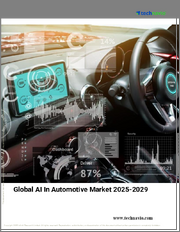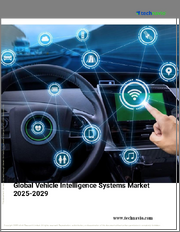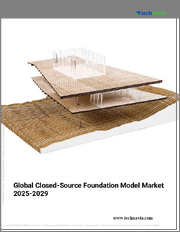
|
시장보고서
상품코드
1629034
자동차 분야 메타버스 시장 규모, 점유율, 성장 분석 : 구성요소별, 기능별, 기술별, 용도별, 지역별 - 산업 예측(2025-2032년)Metaverse In Automotive Market Size, Share, Growth Analysis, By Component (Hardware, Software), By Function (Virtual Platforms/Spaces, Avatars), By Technology, By Application, By Region - Industry Forecast 2025-2032 |
||||||
자동차 분야 메타버스 세계 시장 규모는 2023년 19억 달러로 평가되며, 2024년 26억 7,000만 달러에서 2032년 405억 4,000만 달러로 성장할 것으로 예상되며, 예측 기간(2025-2032년) 동안 연평균 40.5%의 CAGR로 성장할 것으로 예상됩니다.
자동차 분야에서의 메타버스 통합은 무한한 가상 환경과 디지털화폐를 제공함으로써 산업을 빠르게 변화시키고 있습니다. 이러한 진화는 공정 시뮬레이션을 강화하고, 안전성을 향상시키고, 증강현실과 가상현실을 수리에 활용하고, 자동차 원격 쇼핑 경험을 가능하게 합니다. 메타버스 기능을 통해 자동차 회사는 공급망 관리를 최적화하고, 밸류체인의 각 단계를 강화하며, 고객과의 교류와 참여를 강화할 수 있습니다. 이를 통해 시장 일관성 개선, 개발 주기 단축, 제품 품질 향상을 실현할 수 있습니다. 특히, 시뮬레이션은 생산 라인의 효율성을 평가하고, 기후 변화 및 다른 도로 이용자와의 상호작용 등 다양한 조건에서 차량 거동을 모델링하여 차량의 안전성과 사용 편의성을 향상시키고, 보다 안전한 운전 경험을 보장합니다.
목차
소개
- 조사 목적
- 조사 범위
- 정의
조사 방법
- 정보 조달
- 2차 데이터와 1차 데이터 방법
- 시장 규모 예측
- 시장 가정과 제한
주요 요약
- 세계 시장 전망
- 공급과 수요 동향 분석
- 부문별 기회 분석
시장 역학과 전망
- 시장 개요
- 시장 규모
- 시장 역학
- 성장 촉진요인과 기회
- 성장 억제요인과 과제
- Porters 분석
주요 시장 인사이트
- 핵심성공요인
- 경쟁 정도
- 주요 투자 기회
- 시장 생태계
- 시장 매력 지수(2024년)
- PESTEL 분석
- 거시경제 지표
- 밸류체인 분석
- 가격 분석
- 규제 상황
- 사례 연구
- 기술의 진보
- 무역 분석
자동차 분야 메타버스 시장 규모 : 구성요소별
- 시장 개요
- 하드웨어
- VR 헤드셋
- AR 글래스
- 촉각 디바이스
- 3D 프로젝터
- 기타
- 소프트웨어
- 메타버스 플랫폼
- 시뮬레이션 소프트웨어
- 설계 및 프로토타이핑 소프트웨어
- 고객 경험 소프트웨어
- 서비스
- 컨설팅 서비스
- 구현 서비스
- 트레이닝 및 서포트 서비스
- 유지보수와 업그레이드
자동차 분야 메타버스 시장 규모 : 기능별
- 시장 개요
- 가상 플랫폼/공간
- 아바타
- 자산 마켓플레이스
- 금융 서비스
자동차 분야 메타버스 시장 규모 : 기술별
- 시장 개요
- 블록체인
- 가상현실(VR)
- 증강현실(AR)
- 대체 불가능 토큰(NFT)
- 혼합현실(MR)
- 기타
자동차 분야 메타버스 시장 규모 : 용도별
- 시장 개요
- 광고
- 온라인에서의 자동차 구입
- 인포테인먼트
- 카 디자인
- 자율주행차 테스트
- 트레이닝과 시뮬레이션 퍼블릭
- 기타
자동차 분야 메타버스 시장 규모
- 북미
- 미국
- 캐나다
- 유럽
- 독일
- 스페인
- 프랑스
- 영국
- 이탈리아
- 기타 유럽
- 아시아태평양
- 중국
- 인도
- 일본
- 한국
- 기타 아시아태평양
- 라틴아메리카
- 브라질
- 기타 라틴아메리카
- 중동 및 아프리카
- GCC 국가
- 남아프리카공화국
- 기타 중동 및 아프리카
경쟁 정보
- 상위 5개사의 비교
- 주요 기업의 시장 포지셔닝(2024년)
- 주요 시장 기업이 채용한 전략
- 시장의 최근 동향
- 기업의 시장 점유율 분석(2024년)
- 주요 기업 개요
- 기업 개요
- 제품 포트폴리오 분석
- 부문별 점유율 분석
- 매출 전년비 비교(2022-2024)
주요 기업 개요
- NVIDIA Corporation(United States)
- Roblox Corporation(United States)
- Unity Technologies(United States)
- Meta Platforms Inc.(United States)
- WayRay AG(Switzerland)
- Microsoft Corporation(United States)
- BMW Group(Germany)
- Mercedes-Benz AG(Germany)
- Toyota Motor Corporation(Japan)
- Ford Motor Company(United States)
- General Motors(GM)(United States)
- StradVision Inc.(South Korea)
- Eccentric Inc.(United States)
- holoride GmbH(Germany)
- Varjo Technologies(Finland)
- Metadome.ai(Formerly Adloid)(India)
- MG Motor(United Kingdom)
- Tesla, Inc.(United States)
- Waymo LLC(United States)
- Hyundai Motor Company(South Korea)
결론과 추천사항
KSM 25.02.11Global Metaverse In Automotive Market size was valued at USD 1.9 billion in 2023 and is poised to grow from USD 2.67 billion in 2024 to USD 40.54 billion by 2032, growing at a CAGR of 40.5% during the forecast period (2025-2032).
The integration of the metaverse in the automotive sector is rapidly transforming the industry, offering limitless virtual environments and digital currencies. This evolution enhances process simulations, improves safety, and utilizes augmented and virtual reality for repairs, alongside enabling remote shopping experiences for cars. By leveraging metaverse capabilities, automotive companies can optimize supply chain management and enrich every stage of their value chain, fostering greater customer interactions and engagement. This will lead to improved market alignment, accelerated development cycles, and enhanced product quality. Notably, simulations can assess the effectiveness of production lines and boost vehicle safety and usability by modeling vehicle behavior under various conditions, such as climate changes and interactions with other road users, ensuring a safer driving experience.
Top-down and bottom-up approaches were used to estimate and validate the size of the Global Metaverse In Automotive market and to estimate the size of various other dependent submarkets. The research methodology used to estimate the market size includes the following details: The key players in the market were identified through secondary research, and their market shares in the respective regions were determined through primary and secondary research. This entire procedure includes the study of the annual and financial reports of the top market players and extensive interviews for key insights from industry leaders such as CEOs, VPs, directors, and marketing executives. All percentage shares split, and breakdowns were determined using secondary sources and verified through Primary sources. All possible parameters that affect the markets covered in this research study have been accounted for, viewed in extensive detail, verified through primary research, and analyzed to get the final quantitative and qualitative data.
Global Metaverse In Automotive Market Segmental Analysis
Global Metaverse In Automotive Market is segmented by Component, Function, Technology, Application and region. Based on Component, the market is segmented into Hardware, Software and Services. Based on Function, the market is segmented into Virtual Platforms/Spaces, Avatars, Asset Marketplace and Financial Services. Based on Technology, the market is segmented into Blockchain, Virtual Reality (VR), Augmented Reality (AR), Non-fungible Token (NFT), Mixed Reality (MR) and Others. Based on Application, the market is segmented into Advertising, Online Car Purchase, Infotainment, Car Design, Autonomous Car Testing, Training & Simulation Public and Others. Based on region, the market is segmented into North America, Europe, Asia Pacific, Latin America and Middle East & Africa.
Driver of the Global Metaverse In Automotive Market
The Global Metaverse in Automotive market is significantly fueled by the growing trend of gamification, which is being leveraged by leading companies worldwide to enhance brand awareness and engage more effectively with consumers. Through immersive online experiences and virtual world simulations, automotive brands are elevating customer interaction by harnessing the gamified elements of the metaverse. Opportunities in this segment, including BSR, XR, cloud gaming, and the incorporation of AI in social media, alongside innovations like virtual fitting rooms and advanced AR/VR hardware, are presenting new revenue avenues for the automotive industry, catalyzing further growth in the market.
Restraints in the Global Metaverse In Automotive Market
The global metaverse in the automotive market faces significant restraints primarily due to high maintenance costs that can impede its growth. The advanced technologies required to create realistic virtual environments, including extended reality, augmented reality (AR), mixed reality (MR), and various sophisticated semiconductor components and sensor trackers, contribute to elevated expenses. Additionally, enterprise-grade software for the metaverse, such as 3D modeling engines and rendering tools, is costly. These substantial initial investments, coupled with ongoing maintenance requirements, particularly concerning security protocols, can hinder progress in the market and deter potential investments.
Market Trends of the Global Metaverse In Automotive Market
The Global Metaverse in Automotive market is witnessing significant growth, driven by the integration of augmented reality (AR), virtual reality (VR), and mixed reality (MR) into automotive infotainment systems. Leading automotive manufacturers are increasingly collaborating with tech firms to enhance user experiences through immersive technologies that leverage the metaverse. These partnerships aim to transform in-car entertainment, navigation, and user interfaces, making them more interactive and engaging. As consumers demand advanced connectivity and a more personalized driving experience, the metaverse is emerging as a vital component in automotive innovation, poised to reshape the future of mobility and user engagement in the industry.
Table of Contents
Introduction
- Objectives of the Study
- Scope of the Report
- Definitions
Research Methodology
- Information Procurement
- Secondary & Primary Data Methods
- Market Size Estimation
- Market Assumptions & Limitations
Executive Summary
- Global Market Outlook
- Supply & Demand Trend Analysis
- Segmental Opportunity Analysis
Market Dynamics & Outlook
- Market Overview
- Market Size
- Market Dynamics
- Drivers & Opportunities
- Restraints & Challenges
- Porters Analysis
- Competitive rivalry
- Threat of substitute
- Bargaining power of buyers
- Threat of new entrants
- Bargaining power of suppliers
Key Market Insights
- Key Success Factors
- Degree of Competition
- Top Investment Pockets
- Market Ecosystem
- Market Attractiveness Index, 2024
- PESTEL Analysis
- Macro-Economic Indicators
- Value Chain Analysis
- Pricing Analysis
- Regulatory Landscape
- Case Studies
- Technological Advancement
- Trade Analysis
Global Metaverse In Automotive Market Size by Component & CAGR (2025-2032)
- Market Overview
- Hardware
- VR headsets
- AR glasses
- Haptic devices
- 3D projectors
- Others
- Software
- Metaverse platforms
- Simulation software
- Design and prototyping software
- Customer experience software
- Services
- Consulting services
- Implementation services
- Training and support services
- Maintenance and upgrades
Global Metaverse In Automotive Market Size by Function & CAGR (2025-2032)
- Market Overview
- Virtual Platforms/Spaces
- Avatars
- Asset Marketplace
- Financial Services
Global Metaverse In Automotive Market Size by Technology & CAGR (2025-2032)
- Market Overview
- Blockchain
- Virtual Reality (VR)
- Augmented Reality (AR)
- Non-fungible Token (NFT)
- Mixed Reality (MR)
- Others
Global Metaverse In Automotive Market Size by Application & CAGR (2025-2032)
- Market Overview
- Advertising
- Online Car Purchase
- Infotainment
- Car Design
- Autonomous Car Testing
- Training & Simulation Public
- Others
Global Metaverse In Automotive Market Size & CAGR (2025-2032)
- North America (Component, Function, Technology, Application)
- US
- Canada
- Europe (Component, Function, Technology, Application)
- Germany
- Spain
- France
- UK
- Italy
- Rest of Europe
- Asia Pacific (Component, Function, Technology, Application)
- China
- India
- Japan
- South Korea
- Rest of Asia-Pacific
- Latin America (Component, Function, Technology, Application)
- Brazil
- Rest of Latin America
- Middle East & Africa (Component, Function, Technology, Application)
- GCC Countries
- South Africa
- Rest of Middle East & Africa
Competitive Intelligence
- Top 5 Player Comparison
- Market Positioning of Key Players, 2024
- Strategies Adopted by Key Market Players
- Recent Developments in the Market
- Company Market Share Analysis, 2024
- Company Profiles of All Key Players
- Company Details
- Product Portfolio Analysis
- Company's Segmental Share Analysis
- Revenue Y-O-Y Comparison (2022-2024)
Key Company Profiles
- NVIDIA Corporation (United States)
- Company Overview
- Business Segment Overview
- Financial Updates
- Key Developments
- Roblox Corporation (United States)
- Company Overview
- Business Segment Overview
- Financial Updates
- Key Developments
- Unity Technologies (United States)
- Company Overview
- Business Segment Overview
- Financial Updates
- Key Developments
- Meta Platforms Inc. (United States)
- Company Overview
- Business Segment Overview
- Financial Updates
- Key Developments
- WayRay AG (Switzerland)
- Company Overview
- Business Segment Overview
- Financial Updates
- Key Developments
- Microsoft Corporation (United States)
- Company Overview
- Business Segment Overview
- Financial Updates
- Key Developments
- BMW Group (Germany)
- Company Overview
- Business Segment Overview
- Financial Updates
- Key Developments
- Mercedes-Benz AG (Germany)
- Company Overview
- Business Segment Overview
- Financial Updates
- Key Developments
- Toyota Motor Corporation (Japan)
- Company Overview
- Business Segment Overview
- Financial Updates
- Key Developments
- Ford Motor Company (United States)
- Company Overview
- Business Segment Overview
- Financial Updates
- Key Developments
- General Motors (GM) (United States)
- Company Overview
- Business Segment Overview
- Financial Updates
- Key Developments
- StradVision Inc. (South Korea)
- Company Overview
- Business Segment Overview
- Financial Updates
- Key Developments
- Eccentric Inc. (United States)
- Company Overview
- Business Segment Overview
- Financial Updates
- Key Developments
- holoride GmbH (Germany)
- Company Overview
- Business Segment Overview
- Financial Updates
- Key Developments
- Varjo Technologies (Finland)
- Company Overview
- Business Segment Overview
- Financial Updates
- Key Developments
- Metadome.ai (Formerly Adloid) (India)
- Company Overview
- Business Segment Overview
- Financial Updates
- Key Developments
- MG Motor (United Kingdom)
- Company Overview
- Business Segment Overview
- Financial Updates
- Key Developments
- Tesla, Inc. (United States)
- Company Overview
- Business Segment Overview
- Financial Updates
- Key Developments
- Waymo LLC (United States)
- Company Overview
- Business Segment Overview
- Financial Updates
- Key Developments
- Hyundai Motor Company (South Korea)
- Company Overview
- Business Segment Overview
- Financial Updates
- Key Developments



















